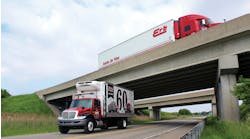The Port of Long Beach announced that the import of cargo containers dropped 43% year-over-year in February, with containers bound for export down 37%. The port attributed the drop to economic weakness and a shift of some cargo to smaller ships going to San Pedro Bay.
"The numbers are now showing what we've been seeing for the past few months -- fewer ships, fewer containers and most troubling, less work for those in port-related businesses," said Port of Long Beach executive director Richard D. Steinke.
"Although cargo has dropped steeply in recent months," Steinke added, "the Port remains committed to financing several major infrastructure projects that are putting local construction and contracting firms to work. Our goal is to keep the Port competitive when the economy rebounds and cargo returns.”
The Port of Los Angeles’ TEU (20-foot equivalent units) dropped 33% year-over-year. In addition, total TEUs fell from 587,004.20 TEUs in January to 413,910.30 in February, the port said.
According to The Heartland Institute’s Environment & Climate News, due to the decrease in income the California ports are beginning to have trouble paying the $20,000 reimbursement per new truck to participating fleets under the Clean Trucks Program. While the ports said still promise to disperse the funds, they have begun delaying paying in some instances, the report said.
While it has not publicly released 2009 numbers, the Port Authority of New York and New Jersey (PANYNJ) said that total container traffic in the port fell in 2008 for the first time since 1993, decreasing from 5,299,105 loaded and empty TEUs in 2007 to 5,265,053 in 2008.
PANYNJ noted that container volume at the top 10 ports in North America declined by an average of 5% in 2008, and predicted that the decreased activity will continue throughout 2009 as the full effect of the downturn is felt.
“Now more than ever, we must work with our industry partners to improve our competitive position if we want to maintain the thousands of jobs and billions in economic activity that the port provides,” said PANYNJ executive director Chris Ward. “At the same time, this is one more indication that the Port Authority is not recession-proof, and we are committed to making the necessary adjustments to our operating and capital budget to reflect economic reality.”
Ports around the country have seen major cargo declines, including the Port of Tacoma, which saw its TEU drop 17% in February year-over-year, and the Port of Tampa, which saw a decrease in total bulk cargo of 6% in 2008.


